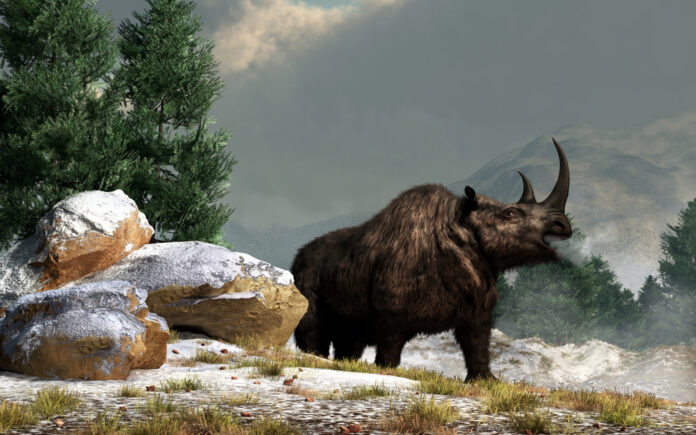The woolly rhinoceros, which roamed northern Eurasia for millions of years, is one of the most iconic extinct megafauna. The formidable thick-skinned, long-furred beast occupied the mammoth steppe, a cold-dry grassland biome that existed during the Last Glacial Maximum (LGM).
However, roughly 10,000 years ago the woolly rhinoceros vanished. Scientists have been able to identify mummified carcasses of these animals, along with bone fragments, and several human cave paintings in Europe and Asia feature the woolly rhinoceros.
The Factors of the Woolly Rhino’s Extinction
Up until now, scientists weren’t sure what role human beings played in the eventual demise of the woolly rhino. However, new research has shed light on the factors that likely led to the gigantic herbivore’s extinction.
“We assessed the ecological mechanisms and threats that are likely to have been integral to population declines and the extinction of the woolly rhinoceros across the 52,000 years prior to extinction at a spatiotemporal resolution higher than that of previous studies,” says Eline Lorenzen from the University of Copenhagen, who co-authored the new study.
Lorenzen and her team used simulations based on the fossil record of woolly rhinos, paleoclimate information (such as temperature and rainfall), and the presence of humans to model interactions of the climate, humans, and the woolly rhinoceros across time and space.
The fossil record of woolly rhinoceros, along with proxy paleoclimate data (such as pollen records, which detail what plants were found in the environment), provide information on the temperature or precipitation of a given location where a fossil has been found.
Lorenzen says the woolly rhino likely lived in a wide ecological niche, with low population abundance and a limited capacity to disperse to new terrains. These factors meant that the large herbivores were on the pathway to extinction before the Holocene, when the combination of cooler temperatures and low, but sustained hunting by humans trapped them in habitats that were suboptimal for their survival.
Read More: The Rise (And Fall) Of The Woolly Rhinoceros
Habitat Problems
By analyzing the stomach contents of the woolly rhino, researchers from a previous study were able to deduce that the species lived on a diet of forbs (herbaceous plants) and graminoids (grasses). Clues were also left in their teeth, where the wear patterns suggest they grazed on vegetation on dry-open landscapes. Wear patterns from subfossils also indicate that the woolly rhino likely used its front horn to expose herbaceous vegetation in shallow snow.
Despite being adapted to cold climates, the woolly rhino is thought to have had an ecological preference for dry-open landscapes with low snow cover. As the climate cooled, however, their habitat shrank, and their physiology — short bulky legs without spreading hooves or pads —would have made moving through deep snow that formed after the last ice age difficult.
“Our modeling indicated that this ecological trap intensified after the end of the last ice age, preventing colonization of newly formed suitable habitats, weakening stabilizing metapopulation processes, triggering the extinction of the woolly rhinoceros in the early Holocene,” Lorenzen explains.
As the planet thawed after the last ice age, populations of woolly rhinoceros were unable to colonize new landscapes and terrains opening up in the north of Eurasia, which caused them to destabilize and crash.
Read More: How Do We Know When a Species Is Extinct?
Explaining the Reasons Behind Extinctions
The new research highlights how the processes which often lead to an extinction can be complex. Extinction can be gradual, happening over thousands of years, where a chain of events can set the demise of a species in motion. While we often think about extinction in simple terms (for example, saying humans wiped out a species), a number of factors like genetic diversity, population size, climate, and size of habitats can all collude to shape the future of a species.
The new research also highlights how a number of megafauna that exist today may be at risk. Human activity has pushed populations of large animals into fragmented and suboptimal habitats. Of the 61 species of large terrestrial herbivores that were alive in the late Pleistocene (129,000 to 11,700 years ago), only eight of these species are still around today.
Read More: Scientists Are Trying to Save These Animals From Extinction
Article Sources
Our writers at Discovermagazine.com use peer-reviewed studies and high-quality sources for our articles, and our editors review for scientific accuracy and editorial standards. Review the sources used below for this article:
Conor Feehly is New Zealand-based science writer who covers a wide range of topics, including astronomy and neuroscience, with an eye for research at the intersection of science and philosophy. He received a masters in science communication degree from the University of Otago. Conor is a regular contributor to Discover Magazine, with his work also appearing in New Scientist, Nautilus Magazine, Live Science, and New Humanist among others. Find him on X
Source : Discovermagazine












